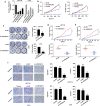LINC02418 promotes colon cancer progression by suppressing apoptosis via interaction with miR-34b-5p/BCL2 axis
- PMID: 32973404
- PMCID: PMC7507712
- DOI: 10.1186/s12935-020-01530-2
LINC02418 promotes colon cancer progression by suppressing apoptosis via interaction with miR-34b-5p/BCL2 axis
Abstract
Background: LncRNAs act as functional regulators in tumor progression through interacting with various signaling pathways in multiple types of cancer. However, the effect of LINC02418 on colorectal cancer (CRC) progression and the underling mechanisms remain unclear.
Methods: LncRNA expression profile in CRC tissues was investigated by the TCGA database. The expressional level of LINC02418 in CRC patients was determined by quantitative reverse transcription-polymerase chain reaction (qRT-PCR). Kaplan-Meier analyses was used to investigate the correlation between LINC02418 and overall survival (OS) of CRC patients. Cell proliferative, migratory and invasive abilities were detected by CCK-8 assays, colony formation assays and trans-well assays in HCT116 and LoVo cells which were stably transduced with sh-LINC02418 or sh-NC. The binding between LINC02418 and miR-34b-5p, and the interaction between miR-34b-5p and BCL2 were determined by dual-luciferase assays. Western blot experiments were conducted to further explore the effect of miR-34b-5p on BCL2 signaling pathway. Rescue experiments were performed to uncover the role of LINC02418/miR-34b-5p/BCL2 axis in CRC progression.
Results: LINC02418 was upregulated in human colon cancer samples when compared with adjacent tissue, and its high expressional level correlated with poor prognosis of CRC patients. LINC02418 promoted cancer progression by enhancing tumor growth, cell mobility and invasiveness of colon cancer cells. Additionally, LINC02418 could physically bind to miR-34b-5p and subsequently affect BCL2 signaling pathway. Down-regulation of LINC02418 reduced cell proliferation, while transfection of miR-34b-5p inhibitor or BCL2 into LINC02418-silenced CRC cells significantly promoted CRC cells growth.
Conclusions: LINC02418 was upregulated in human CRC samples and could be used as the indicator for prediction of prognosis. LINC02418 acted as a tumor driver by negatively regulating cell apoptosis through LINC02418/miR-34b-5p/BCL2 axis in CRC.
Keywords: BCL2; Colorectal cancer; LINC02418; ceRNA; microRNA-34b-5p.
© The Author(s) 2020.
Conflict of interest statement
Competing interestsThe authors declare that they have no competing interests.
Figures





Similar articles
-
Cancer-associated fibroblast exosome LINC00355 promotes epithelial-mesenchymal transition and chemoresistance in colorectal cancer through the miR-34b-5p/CRKL axis.Cancer Gene Ther. 2024 Feb;31(2):259-272. doi: 10.1038/s41417-023-00700-4. Epub 2023 Dec 5. Cancer Gene Ther. 2024. PMID: 38052858
-
Expression and Significance of LINC02418 in Breast Cancer.Breast Cancer (Dove Med Press). 2024 Apr 24;16:233-243. doi: 10.2147/BCTT.S454054. eCollection 2024. Breast Cancer (Dove Med Press). 2024. PMID: 38694704 Free PMC article.
-
MYC-regulated lncRNA NEAT1 promotes B cell proliferation and lymphomagenesis via the miR-34b-5p-GLI1 pathway in diffuse large B-cell lymphoma.Cancer Cell Int. 2020 Mar 19;20:87. doi: 10.1186/s12935-020-1158-6. eCollection 2020. Cancer Cell Int. 2020. PMID: 32206038 Free PMC article.
-
Long noncoding RNA LINC02418 regulates MELK expression by acting as a ceRNA and may serve as a diagnostic marker for colorectal cancer.Cell Death Dis. 2019 Jul 29;10(8):568. doi: 10.1038/s41419-019-1804-x. Cell Death Dis. 2019. PMID: 31358735 Free PMC article.
-
Role of microRNA-34b-5p in cancer and injury: how does it work?Cancer Cell Int. 2022 Dec 1;22(1):381. doi: 10.1186/s12935-022-02797-3. Cancer Cell Int. 2022. PMID: 36457043 Free PMC article. Review.
Cited by
-
Thymoquinone Potentially Modulates the Expression of Key Onco- and Tumor Suppressor miRNAs in Prostate and Colon Cancer Cell Lines: Insights from PC3 and HCT-15 Cells.Genes (Basel). 2023 Aug 30;14(9):1730. doi: 10.3390/genes14091730. Genes (Basel). 2023. PMID: 37761870 Free PMC article.
-
Expression characteristics of long non-coding RNA in colon adenocarcinoma and its potential value for judging the survival and prognosis of patients: bioinformatics analysis based on The Cancer Genome Atlas database.J Gastrointest Oncol. 2022 Jun;13(3):1178-1187. doi: 10.21037/jgo-22-384. J Gastrointest Oncol. 2022. PMID: 35837189 Free PMC article.
-
Identification of Tumor Microenvironment-Related Prognostic lncRNAs in Lung Adenocarcinoma.Front Oncol. 2021 Aug 2;11:719812. doi: 10.3389/fonc.2021.719812. eCollection 2021. Front Oncol. 2021. PMID: 34408984 Free PMC article.
-
Cancer-associated fibroblasts-derived extracellular vesicles carrying lncRNA SNHG3 facilitate colorectal cancer cell proliferation via the miR-34b-5p/HuR/HOXC6 axis.Cell Death Discov. 2022 Aug 3;8(1):346. doi: 10.1038/s41420-022-01116-z. Cell Death Discov. 2022. PMID: 35922404 Free PMC article.
-
Decoding the regulatory landscape of lncRNAs as potential diagnostic and prognostic biomarkers for gastric and colorectal cancers.Clin Exp Med. 2024 Jan 31;24(1):29. doi: 10.1007/s10238-023-01260-5. Clin Exp Med. 2024. PMID: 38294554 Free PMC article. Review.
References
-
- Feb: World cancer report 2014. World Health Organization 2015.
-
- Kanth P, Grimmett J, Champine M, Burt R, Samadder NJ. Hereditary colorectal polyposis and cancer syndromes: a primer on diagnosis and management. Am J Gastroenterol. 2017;112(10):1509–1525. - PubMed
LinkOut - more resources
Full Text Sources

